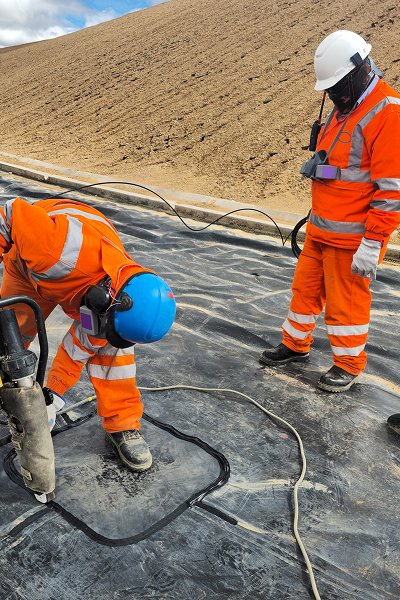Basic characteristics of high-strength geocell
High-strength geocells are made of strips of HDPE, PP, or other polymers, connected by ultrasonic welding or perforation to form a three-dimensional honeycomb structure. When stretched, they form honeycomb spaces that can be filled with soil, gravel, concrete, and other materials.


Performance characteristics
High-Strength Tensile Performance
High-strength geocells can withstand significant tensile stresses, typically with a tensile strength of 20-50 kN/m, far exceeding that of traditional geonets or geotextiles, and offer advantages in withstanding sliding and impact loads.
Weather and Aging Resistance
Treatment with UV stabilizers ensures long-term use without degradation in harsh environments such as high temperatures, cold, acidic and alkaline conditions, and water immersion, with a service life typically exceeding 20 years.
Flexibility and Adaptability to Uneven Settlement
Compared to rigid structures (such as concrete slope protection), geocells offer superior flexibility, adapting to adverse conditions such as localized subsidence, frost heave, and seismic disturbances, and are less susceptible to cracking.
Difficulties in engineering reinforcement of steep slopes
Steep terrain
Steep slopes are typically characterized by steep gradients, dramatic undulations, and rugged terrain. Gradients of 1:1 or even steeper (over 45°) are common. This results in:
Construction machinery is inaccessible or has limited operating space;
Manual construction is difficult and poses high risks to construction workers;
Material transportation and lifting are extremely inconvenient;
Setting up temporary roads or construction platforms is time-consuming and labor-intensive.
Loose soil with low mechanical strength
Steep slopes are often composed of the following types of geological materials:
Weathered rock layers (such as mudstone and shale): loose structure and weak shear resistance;
Residual soil/accumulated soil: fill or natural deposits, easily softened by water;
Residual landslide areas: areas with a history of deformation and unclear slip surfaces.
Severe rainwater erosion and infiltration
Slope erosion: causes soil loss and exposes plant roots;
Softened shear surfaces: Rainwater seeps through joints or microcracks, triggering deep sliding;
Increased pore water pressure: Cohesive soil slopes, in particular, are prone to sliding failure after rainfall.
Reference for high-strength geocell steep slope reinforcement
Key design parameters
Cell Height
Commonly available cell heights are 10cm, 15cm, and 20cm.
For steep slopes, it is recommended to use cells 15cm or higher to provide greater lateral restraint and anti-slip performance.
For localized high-risk areas (such as near sliding surfaces), custom-designed cells 25cm or higher can be used.
Welding Distance
The standard welding distance is 330mm or 445mm.
The smaller the distance, the higher the overall structural strength of the cell.
For slopes with high load-bearing requirements and high sliding forces, a welding distance of 260-330mm is recommended to improve stability.
Material Strength and Thickness
HDPE thickness is generally 1.0-1.5mm, and its tensile strength should be ≥20kN/m.
For areas with high temperatures and high UV exposure, composite polymer cells containing stabilizers and anti-aging agents are recommended.
Reinforced PP or EVA-based cells can be used in heavy-load areas such as mining areas and stockpiling platforms.
Layout Methods
Contour Layout: Cells are laid out along the slope's contours, facilitating interlayer coordination and water flow guidance.
Step Layout: Suitable for different conditions at the toe and crest of the slope, with cells nested step by step.
Fish-Scale Layout: Suitable for particularly steep or irregular terrain, with overlapping connections for enhanced tensile strength.
Anchorage Structure Design
Anchorage Length: ≥1.5m; 2-2.5m is recommended in areas with heavy slippage.
Anchorage Type: L-shaped steel anchors, titanium alloy anchors, or spiral anchors can be used.
Anchorage points should be located at the four corners and center of the cell to ensure uniform load distribution.
A "capping and pressure cell" should be installed at the top of the slope to prevent overall slippage.
Common Application Scenarios of High-Strength Geocells in Slope Reinforcement
1. Highway and Railway Embankments
Application: Slope protection on embankments, especially in mountainous or hilly terrains.
Challenges: Steep slopes, heavy traffic-induced vibrations, rainfall erosion.
Geocell Role: Provides lateral confinement to fill materials, reduces surface erosion, improves overall slope stability.
Benefits: Rapid construction, long-term durability, compatibility with vegetation for ecological restoration.
2.Mining Sites and Dump Slopes
Application: Stabilizing waste dump slopes, tailings dams, and overburden piles.
Challenges: Poor soil quality, high risk of slope failure, environmental compliance.
Geocell Role: Forms a reinforced matrix with local fill, enhances shear resistance, enables vegetative cover.
Benefits: Cost-effective reuse of site material, dust control, meets safety and environmental standards.
3. Riverbanks and Reservoir Embankments
Application: Protection of slopes subjected to water flow and wave action.
Challenges: Hydraulic erosion, saturation-induced instability, variable water levels.
Geocell Role: Acts as a flexible revetment system, can be filled with concrete, stone, or soil, and withstands repeated wetting and drying.
Benefits: High resistance to scour and erosion, adaptable to settlements, allows for green solutions.
4. Landfill Cover Systems
Application: Stabilizing final cover systems on landfill slopes.
Challenges: Low bearing capacity of underlying waste, risk of surface sliding, leachate seepage.
Geocell Role: Reinforces soil layers on steep caps, holds vegetation layers in place, integrates with drainage systems.
Benefits: Promotes long-term integrity of landfill covers, supports ecological restoration, reduces maintenance costs.
5.Retaining Slope Systems in Urban Construction
Application: Construction of landscaped reinforced slopes in urban parks, campuses, or residential zones.
Challenges: Space constraints, aesthetic requirements, shallow foundations.
Geocell Role: Creates gravity-type or reinforced soil retaining systems with vegetation integration.
Benefits: Blends with the environment, enables vertical or near-vertical green walls, supports pedestrian and light vehicle loads.






